Peugeot 508 Hybrid 2014 User Guide
Manufacturer: PEUGEOT, Model Year: 2014, Model line: 508 Hybrid, Model: Peugeot 508 Hybrid 2014Pages: 380, PDF Size: 10.94 MB
Page 11 of 380
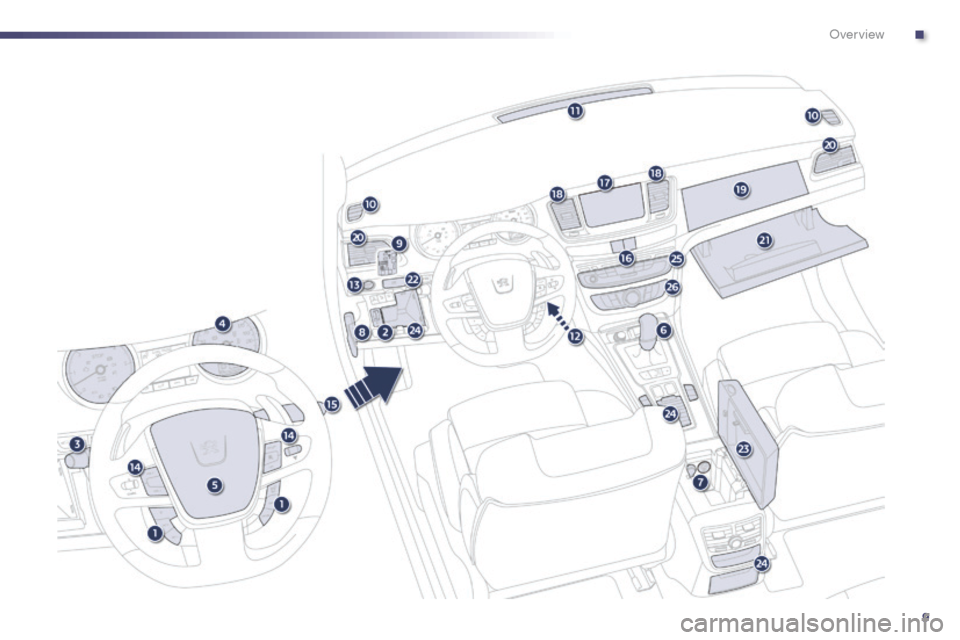
9
508_en_Chap00b_vue-ensemble_ed02-2014
.
Over view
Page 12 of 380
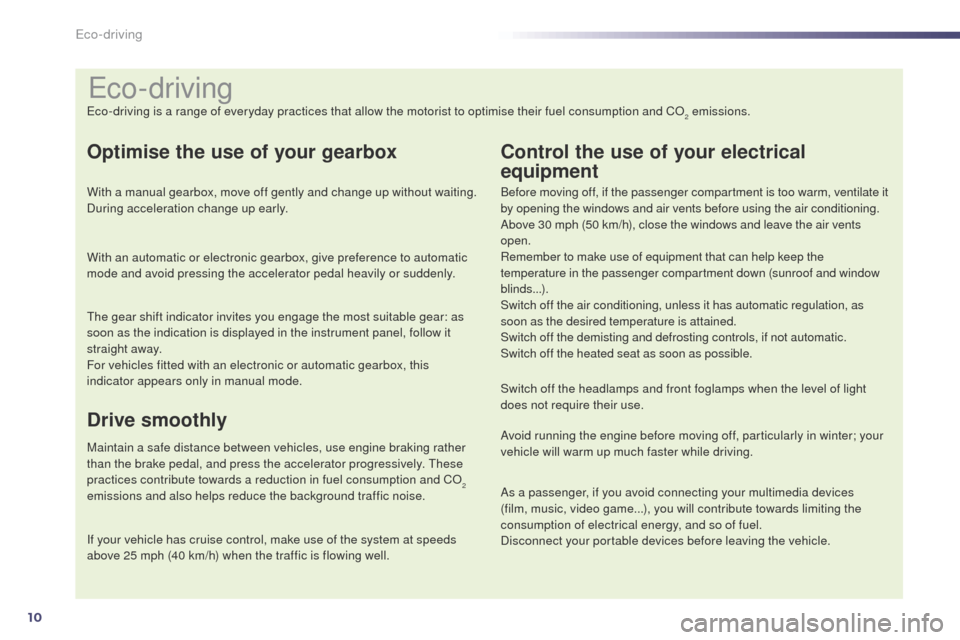
10
eco-driving
eco-driving is a range of everyday practices that allow the motorist to optimise their fuel consumption and CO2 emissions.
Optimise the use of your gearbox
With a manual gearbox, move off gently and change up without waiting.
During acceleration change up early.
With an automatic or electronic gearbox, give preference to automatic
mode and avoid pressing the accelerator pedal heavily or suddenly.
th
e gear shift indicator invites you engage the most suitable gear: as
soon as the indication is displayed in the instrument panel, follow it
straight away.
For vehicles fitted with an electronic or automatic gearbox, this
indicator appears only in manual mode.
Drive smoothly
Maintain a safe distance between vehicles, use engine braking rather
than the brake pedal, and press the accelerator progressively. th ese
practices contribute towards a reduction in fuel consumption and CO
2
emissions and also helps reduce the background traffic noise.
If your vehicle has cruise control, make use of the system at speeds
above 25 mph (40 km/h) when the traffic is flowing well.
Control the use of your electrical
equipment
Before moving off, if the passenger compartment is too warm, ventilate it
by opening the windows and air vents before using the air conditioning.
Above 30 mph (50 km/h), close the windows and leave the air vents
open.
Remember to make use of equipment that can help keep the
temperature in the passenger compartment down (sunroof and window
blinds...).
Switch off the air conditioning, unless it has automatic regulation, as
soon as the desired temperature is attained.
Switch off the demisting and defrosting controls, if not automatic.
Switch off the heated seat as soon as possible.
Switch off the headlamps and front foglamps when the level of light
does not require their use.
Avoid running the engine before moving off, particularly in winter; your
vehicle will warm up much faster while driving.
As a passenger, if you avoid connecting your multimedia devices
(film, music, video game...), you will contribute towards limiting the
consumption of electrical energy, and so of fuel.
Disconnect your portable devices before leaving the vehicle.
eco-driving
Page 13 of 380
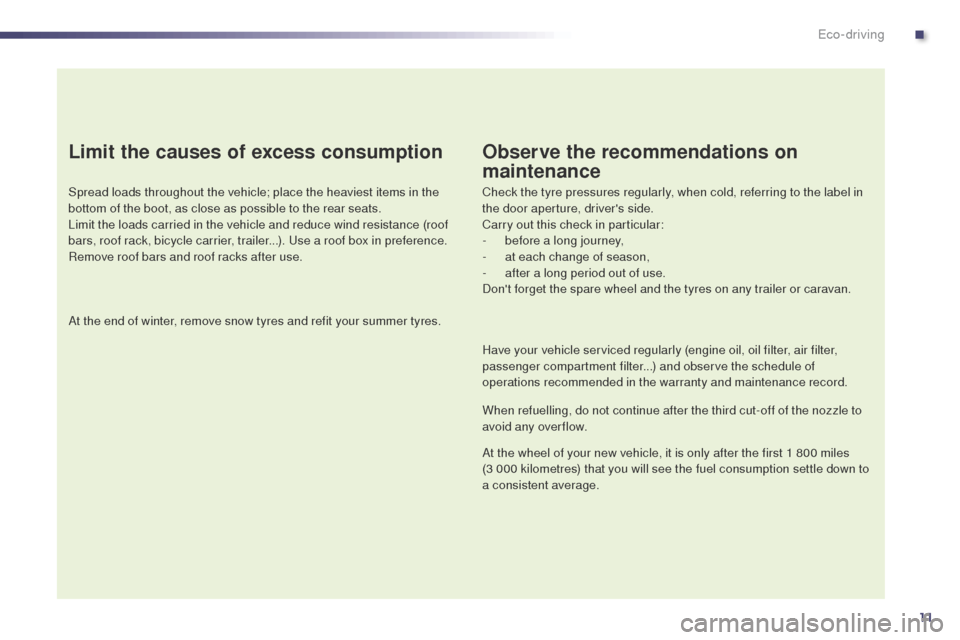
11
Limit the causes of excess consumption
Spread loads throughout the vehicle; place the heaviest items in the
bottom of the boot, as close as possible to the rear seats.
Limit the loads carried in the vehicle and reduce wind resistance (roof
bars, roof rack, bicycle carrier, trailer...). u
s
e a roof box in preference.
Remove roof bars and roof racks after use.
At the end of winter, remove snow tyres and refit your summer tyres.
Observe the recommendations on
maintenance
Check the tyre pressures regularly, when cold, referring to the label in
the door aperture, driver's side.
Carry out this check in particular:
-
b
efore a long journey,
-
a
t each change of season,
-
a
fter a long period out of use.
Don't forget the spare wheel and the tyres on any trailer or caravan.
Have your vehicle serviced regularly (engine oil, oil filter, air filter,
passenger compartment filter...) and observe the schedule of
operations recommended in the warranty and maintenance record.
When refuelling, do not continue after the third cut-off of the nozzle to
avoid any over flow.
At the wheel of your new vehicle, it is only after the first 1 800 miles
(3 000 kilometres) that you will see the fuel consumption settle down to
a consistent average.
.
Eco-driving
Page 14 of 380
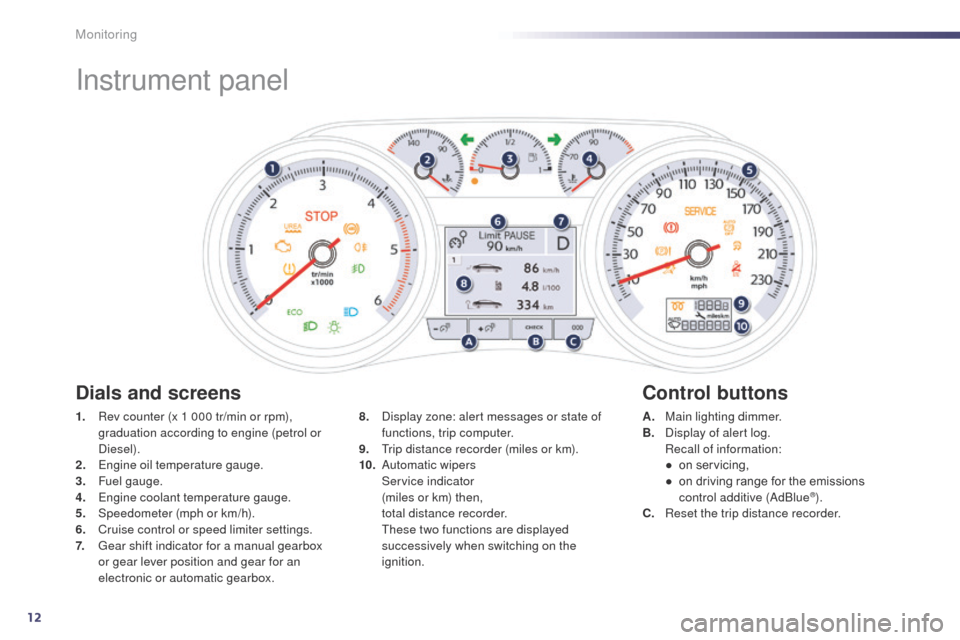
12
Monitoring
Instrument panel
1. Rev counter (x 1 000 tr/min or rpm), graduation according to engine (petrol or
Diesel).
2.
e
n
gine oil temperature gauge.
3.
F
uel gauge.
4.
e
ng
ine coolant temperature gauge.
5.
Spe
edometer (mph or km/h).
6.
C
ruise control or speed limiter settings.
7.
g
e
ar shift indicator for a manual gearbox
or gear lever position and gear for an
electronic or automatic gearbox. A. M
ain lighting dimmer.
B. D isplay of alert log.
R
ecall of information:
●
o
n servicing,
●
o
n driving range for the emissions
control additive (AdBlue
®).
C. R
eset the trip distance recorder.
8.
D
isplay zone: alert messages or state of
functions, trip computer.
9.
t
r
ip distance recorder (miles or km).
10.
Aut
omatic wipers
S
ervice indicator (
miles or km) then, t
otal distance recorder.
t
h
ese two functions are displayed
successively when switching on the
ignition.
Dials and screens Control buttons
Page 15 of 380
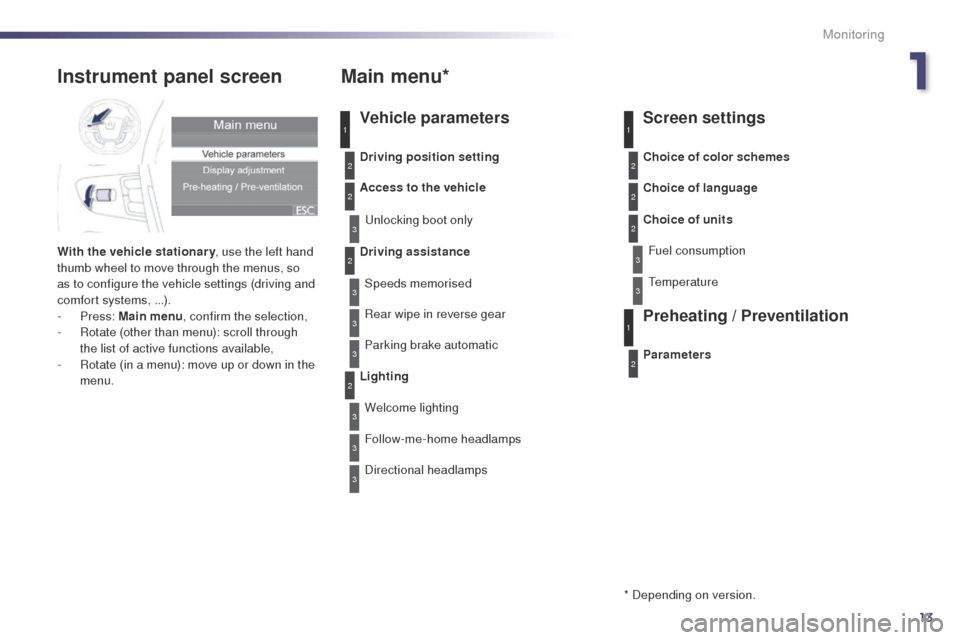
13
1
2
2
2
2
3
3
3
3
3
3
3
Instrument panel screen
With the vehicle stationary, use the left hand
thumb wheel to move through the menus, so
as to configure the vehicle settings (driving and
comfort systems, ...).
-
Press: Main menu , confirm the selection,
-
R
otate (other than menu): scroll through
the list of active functions available,
-
R
otate (in a menu): move up or down in the
menu.
Main menu*
Vehicle parameters Screen settings
Preheating / Preventilation
Driving position setting
Access to the vehicle
unl
ocking boot only
Driving assistance Speeds memorised
Rear wipe in reverse gear
Parking brake automatic
Lighting Welcome lighting
Follow-me-home headlamps
Directional headlamps Parameters Choice of color schemes
Choice of language
Choice of units
Fuel consumption
1
2
2
2
3
3
1
2
* Depending on version.
te
mperature
1
Monitoring
Page 16 of 380
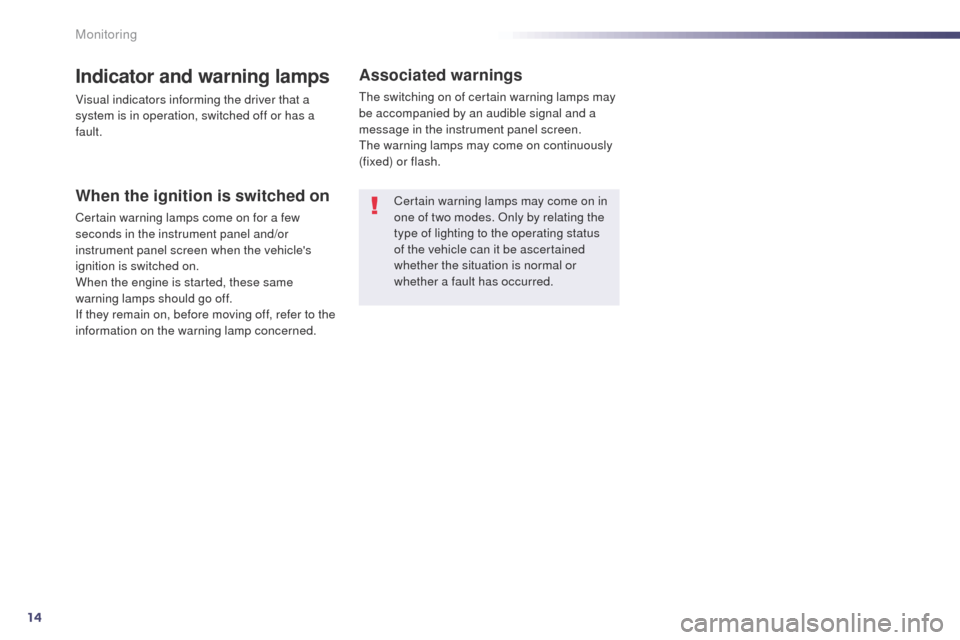
14
Indicator and warning lamps
Visual indicators informing the driver that a
system is in operation, switched off or has a
fault.
When the ignition is switched on
Certain warning lamps come on for a few
seconds in the instrument panel and/or
instrument panel screen when the vehicle's
ignition is switched on.
When the engine is started, these same
warning lamps should go off.
If they remain on, before moving off, refer to the
information on the warning lamp concerned.
Associated warnings
the switching on of certain warning lamps may
be accompanied by an audible signal and a
message in the instrument panel screen.
th
e warning lamps may come on continuously
(fixed) or flash.
Certain warning lamps may come on in
one of two modes. Only by relating the
type of lighting to the operating status
of the vehicle can it be ascertained
whether the situation is normal or
whether a fault has occurred.
Monitoring
Page 17 of 380
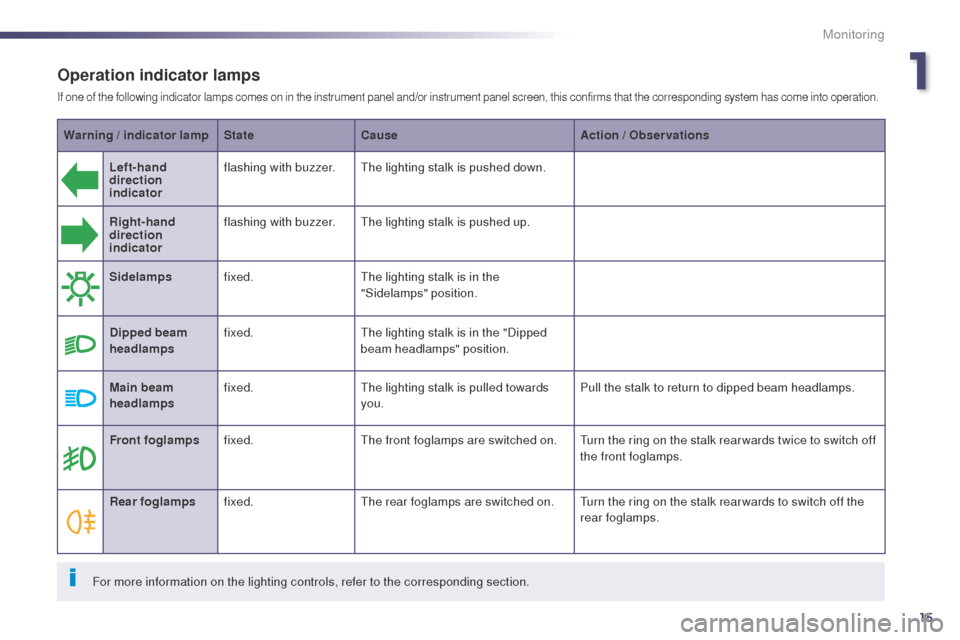
15
Operation indicator lamps
If one of the following indicator lamps comes on in the instrument panel and/or instrument panel screen, this confirms that the corresponding system has come into operation.
Warning / indicator lampStateCause Action / Observations
Left-hand
direction
indicato r flashing with buzzer.
th
e lighting stalk is pushed down.
Right-hand
direction
indicator flashing with buzzer.
th
e lighting stalk is pushed up.
Sidelamps fixed.
th
e lighting stalk is in the
"Sidelamps" position.
Dipped beam
headlamps fixed.
th
e lighting stalk is in the "Dipped
beam headlamps" position.
Main beam
headlamps fixed.
th
e lighting stalk is pulled towards
you. Pull the stalk to return to dipped beam headlamps.
Front foglamps fixed.
th
e front foglamps are switched on.
tu
rn the ring on the stalk rear wards twice to switch off
the front foglamps.
Rear foglamps fixed.
th
e rear foglamps are switched on.
tu
rn the ring on the stalk rear wards to switch off the
rear foglamps.
For more information on the lighting controls, refer to the corresponding section.
1
Monitoring
Page 18 of 380
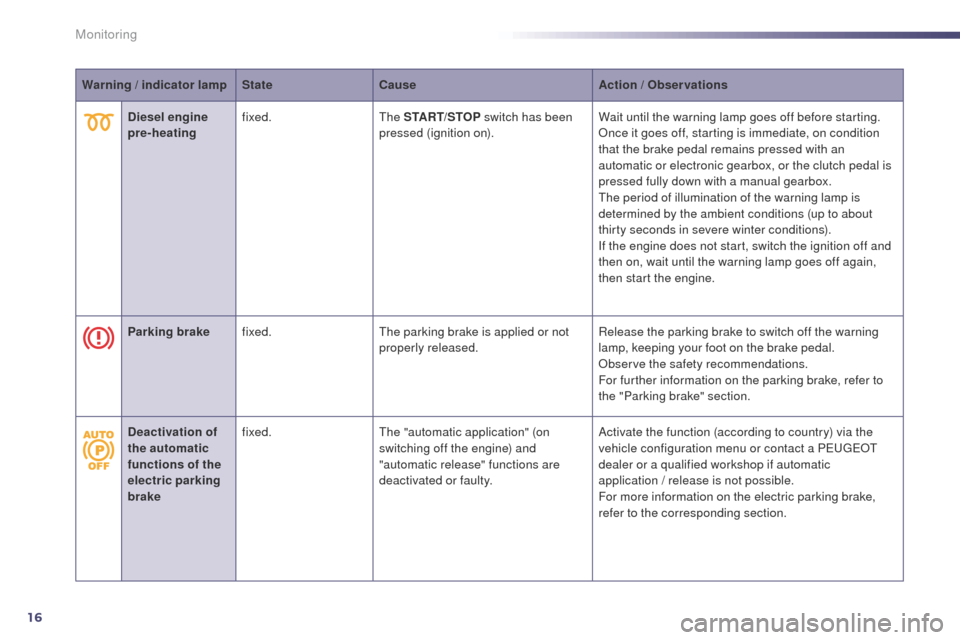
16
Warning / indicator lampStateCause Action / Observations
Diesel engine
pre-heating fixed.
th
e START/STOP switch has been
pressed (ignition on). Wait until the warning lamp goes off before starting.
Once it goes off, starting is immediate, on condition
that the brake pedal remains pressed with an
automatic or electronic gearbox, or the clutch pedal is
pressed fully down with a manual gearbox.
th
e period of illumination of the warning lamp is
determined by the ambient conditions (up to about
thirty seconds in severe winter conditions).
If the engine does not start, switch the ignition off and
then on, wait until the warning lamp goes off again,
then start the engine.
Parking brake fixed.
th
e parking brake is applied or not
properly released. Release the parking brake to switch off the warning
lamp, keeping your foot on the brake pedal.
Observe the safety recommendations.
For further information on the parking brake, refer to
the "Parking brake" section.
Deactivation of
the automatic
functions of the
electric parking
brake fixed.
th
e "automatic application" (on
switching off the engine) and
"automatic release" functions are
deactivated or faulty. Activate the function (according to country) via the
vehicle configuration menu or contact a P
e
uge
Ot
dealer or a qualified workshop if automatic
application
/ release is not possible.
For more information on the electric parking brake,
refer to the corresponding section.
Monitoring
Page 19 of 380
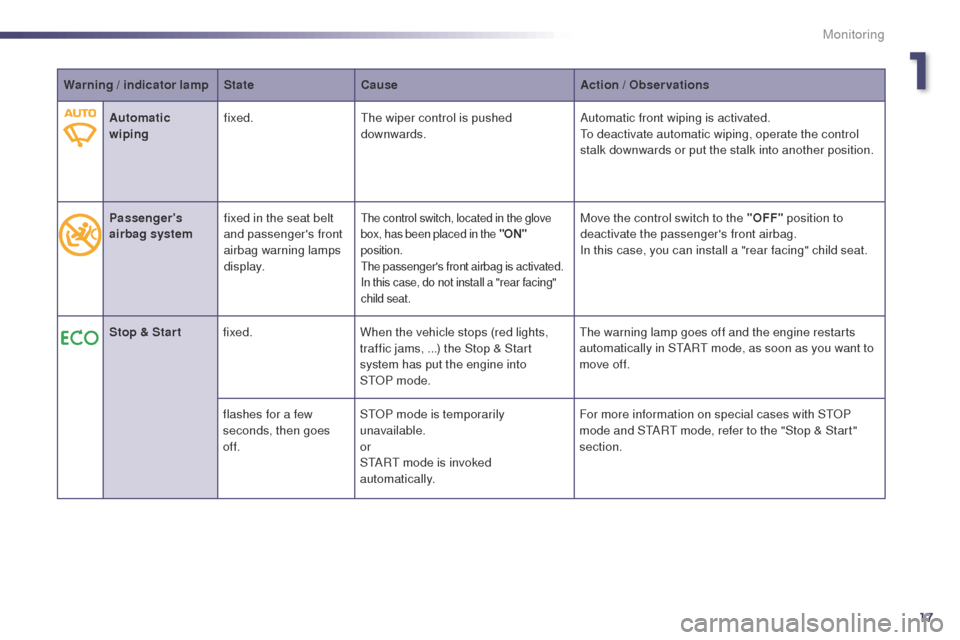
17
Warning / indicator lampStateCause Action / Observations
Automatic
wiping fixed.
th
e wiper control is pushed
downwards. Automatic front wiping is activated.
to d
eactivate automatic wiping, operate the control
stalk downwards or put the stalk into another position.
Passenger's
airbag system fixed in the seat belt
and passenger's front
airbag warning lamps
display.
the control switch, located in the glove
box, has been placed in the "ON"
position.
the
passenger's front airbag is activated.
In this case, do not install a "rear facing"
child seat.Move the control switch to the "OFF" position to
deactivate the passenger's front airbag.
In this case, you can install a "rear facing" child seat.
Stop & Star t fixed. When the vehicle stops (red lights,
traffic jams, ...) the Stop & Start
system has put the engine into
S
t
OP
mode.
th
e warning lamp goes off and the engine restarts
automatically in S
tA
R
t
mode, as soon as you want to
move off.
flashes for a few
seconds, then goes
of f. S
tO
P mode is temporarily
unavailable.
or
S
tA
R
t
mode is invoked
automatically. For more information on special cases with S
tO
P
mode and S
tA
R
t
mode, refer to the "Stop & Start"
section.
1
Monitoring
Page 20 of 380
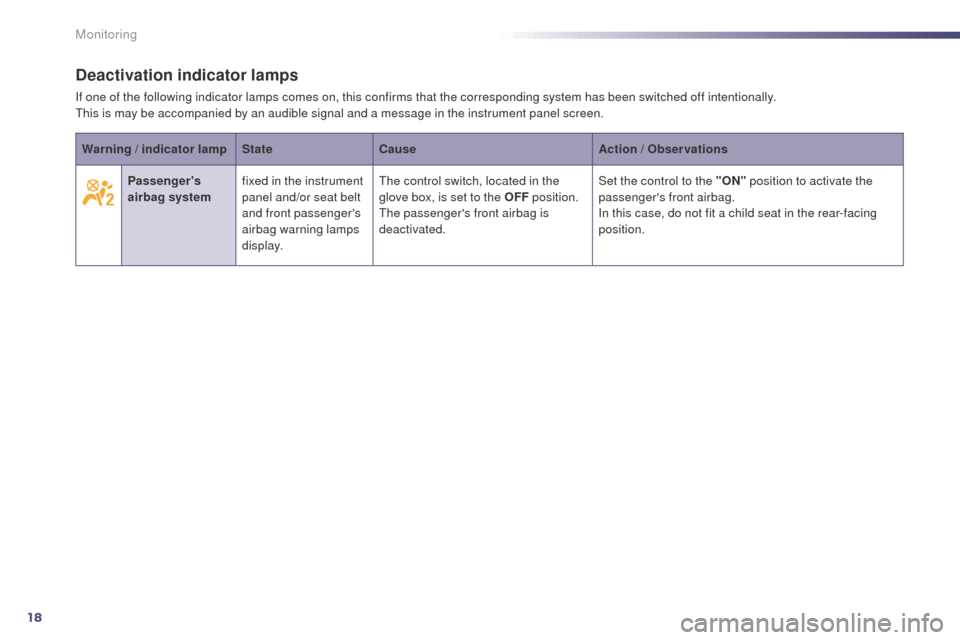
18
Deactivation indicator lamps
If one of the following indicator lamps comes on, this confirms that the corresponding system has been switched off intentionally.this is may be accompanied by an audible signal and a message in the instrument panel screen.
Warning / indicator lamp StateCause Action / Observations
Passenger's
airbag system fixed in the instrument
panel and/or seat belt
and front passenger's
airbag warning lamps
display.
th
e control switch, located in the
glove box, is set to the OFF position.
the
passenger's front airbag is
deactivated. Set the control to the "ON"
position to activate the
passenger's front airbag.
In this case, do not fit a child seat in the rear-facing
position.
Monitoring